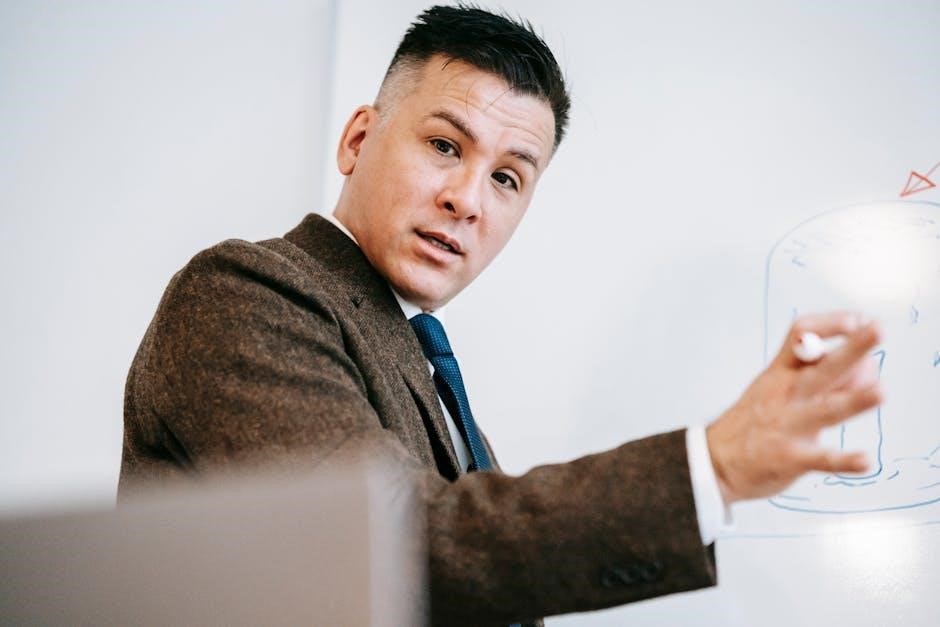Teaching and coaching are instructional practices that guide learning and development. Both involve empowering individuals to achieve their potential through structured guidance and support, fostering growth and understanding.
1.1. Definition of Teaching and Coaching
Teaching involves imparting knowledge and skills through structured lessons, often in a classroom setting, to help students understand and apply concepts. Coaching, while similar, focuses on guiding individuals or teams to achieve specific goals through personalized support and feedback. Both practices emphasize instruction but differ in approach—teaching is typically curriculum-driven, while coaching is more adaptive and centered on individual needs and performance improvement. Both roles require strong communication and the ability to adapt strategies to foster learning and growth.
1.2. The Role of Instruction in Both Fields
Instruction serves as the cornerstone of both teaching and coaching, enabling the transfer of knowledge and skills. In teaching, instruction is structured to meet curriculum requirements, ensuring students grasp key concepts. In coaching, instruction is tailored to enhance performance and achieve specific objectives. Both fields rely on intentional planning, delivery of content, and the use of strategies to engage learners. Effective instruction in teaching and coaching fosters understanding, critical thinking, and personal growth, making it essential for successful outcomes in educational and professional development settings;

Similarities Between Teaching and Coaching
Teaching and coaching share commonalities as instructional practices aimed at fostering learning and development. Both emphasize goal-setting, feedback, and personalized approaches to enhance skills and knowledge effectively.
2.1. Goal-Oriented Instruction
Both teaching and coaching are rooted in setting clear, achievable goals. Instructors in both fields establish objectives to guide learners towards mastery, ensuring progress is measurable and purposeful. By aligning activities with desired outcomes, educators and coaches help individuals stay focused on their development. This structured approach not only enhances learning efficiency but also builds confidence and motivation. Goal-oriented instruction ensures that the learning process is deliberate, with each step contributing to the ultimate objective of fostering skill acquisition and personal growth.
2.2. Use of Feedback and Assessment
Feedback and assessment are integral to both teaching and coaching. They provide insights into learner progress, helping to refine instruction and guide improvement. Regular feedback fosters reflection and growth, while assessments measure understanding and skill mastery. Whether through formal tests or informal check-ins, these tools enable educators and coaches to adjust their strategies, ensuring learners stay on track. Constructive feedback, in particular, encourages development by highlighting strengths and areas for improvement, creating a supportive environment for continuous learning and achievement.
2.3. Focus on Learning and Development
Teaching and coaching both prioritize learning and development, aiming to enhance knowledge, skills, and personal growth. They emphasize understanding over mere memorization, fostering critical thinking and problem-solving abilities. Both practices encourage active participation, engagement, and reflection, creating environments where individuals can thrive. By tailoring approaches to meet diverse needs, educators and coaches ensure that learners achieve their full potential, whether in academic or professional settings. This shared focus on growth underscores the transformative impact of both fields on individuals and society alike, driving continuous improvement and lifelong learning.

Differences Between Teaching and Coaching
Teaching often follows a structured curriculum, while coaching is more personalized and adaptive. Teaching is typically one-to-many, whereas coaching is one-on-one, focusing on individual needs and goals.
3.1. Classroom vs. One-on-One Settings
Teaching typically occurs in a classroom setting, where instructors deliver lessons to a group of students, following a structured curriculum. In contrast, coaching often happens in one-on-one interactions, allowing for personalized attention and tailored strategies. While teaching focuses on imparting knowledge to a collective audience, coaching emphasizes individualized support and development. The classroom environment fosters a broader, standardized approach, whereas coaching thrives in adaptive, dynamic interactions. This distinction highlights the unique strengths of each method, catering to different learning and developmental needs.
3.2. Curriculum-Based vs. Personalized Learning
Teaching often revolves around a predefined curriculum, ensuring students meet standardized learning objectives. Coaching, however, focuses on personalized learning, adapting strategies to individual needs and goals. While teaching emphasizes broad knowledge transmission, coaching tailors instruction to address specific strengths and weaknesses. This contrast reflects the differing priorities of each practice—teaching aiming for collective proficiency and coaching for individual mastery. By understanding these approaches, educators and coaches can align their methods with the unique requirements of their learners, optimizing outcomes in both educational and developmental contexts effectively.
3.3. Authority vs. Collaboration
Teaching traditionally involves a hierarchical structure, with the teacher as the authority figure imparting knowledge. In contrast, coaching emphasizes collaboration, fostering a partnership where the coach and individual work together to achieve goals; Teaching often relies on the teacher’s expertise, while coaching encourages mutual respect and shared decision-making. This shift from authority to collaboration reflects different approaches to instruction, with teaching focusing on knowledge transfer and coaching on empowering individuals to take ownership of their learning and development through active participation and dialogue.

Skills Required for Effective Teaching and Coaching
Effective teaching and coaching demand strong communication, empathy, and adaptability. These skills ensure clear guidance, emotional support, and personalized learning experiences for diverse individuals.
4.1. Communication Skills
Effective communication is crucial in both teaching and coaching. Clear articulation of ideas helps students and clients understand concepts. Active listening ensures comprehension and builds trust. Verbal and non-verbal cues, such as tone and body language, enhance message delivery. Adapting communication styles to diverse audiences fosters engagement and inclusivity. Regular feedback exchanges promote growth and clarify expectations. Strong communication skills create a supportive environment, enabling learners to achieve their goals and develop confidence in their abilities. These skills are foundational for successful instruction and meaningful connections.
4.2. Empathy and Emotional Intelligence
Empathy and emotional intelligence are vital for effective teaching and coaching. Understanding learners’ emotions and perspectives fosters a supportive environment. Recognizing individual challenges helps tailor instruction to meet diverse needs. Emotional intelligence enables instructors to manage their own emotions, fostering resilience and patience. Building trust through empathy encourages open communication and collaboration. These qualities help create a safe, inclusive space where learners feel valued and motivated to grow. By prioritizing emotional connections, educators and coaches can address the whole person, enhancing both academic and personal development. This approach strengthens relationships and amplifies the impact of instruction. It is essential for meaningful engagement and lasting growth.
4.3. Adaptability and Flexibility
Adaptability and flexibility are crucial for effective teaching and coaching, as they enable instructors to respond to diverse needs and changing circumstances. Educators must tailor their approaches to suit individual learning styles, while coaches adjust strategies to optimize performance. Flexibility allows for spontaneous adjustments, ensuring relevance and engagement. In dynamic environments, adaptability fosters resilience and creativity, helping instructors remain effective. By staying open to new methods and feedback, teachers and coaches can continuously refine their practices. This ensures personalized growth and maximizes learning potential, making adaptability a cornerstone of successful instruction and mentorship.

Tools and Strategies for Instruction
Effective instruction relies on tools like lesson planning, curriculum design, and active listening, combined with strategies such as questioning techniques and technology integration to enhance learning experiences.
5.1. Lesson Planning and Curriculum Design
Lesson planning and curriculum design are foundational tools in both teaching and coaching, enabling structured delivery of content. Coaches often adapt teaching methods to create personalized learning paths, ensuring alignment with learner goals. Effective curriculum design involves outlining clear objectives, selecting relevant materials, and assessing progress. In coaching, this may translate to tailored development plans, while teachers use it to meet diverse classroom needs. Both fields emphasize the importance of flexibility and adaptability in their designs to accommodate varied learning styles and evolving requirements, ensuring comprehensive and impactful instruction.
5.2. Active Listening and Questioning Techniques
Active listening and questioning are vital in teaching and coaching, fostering deeper understanding and engagement. Educators use intentional questioning to scaffold thinking, encouraging learners to explore ideas critically. Coaches employ open-ended questions to uncover underlying beliefs and guide reflection. Both practices require attentiveness to verbal and non-verbal cues, ensuring meaningful interactions. Effective questioning stimulates curiosity, clarifies concepts, and reveals misconceptions, while active listening builds trust and rapport, creating a supportive environment for growth and learning in both educational and developmental contexts.
5.3. Technology Integration
Technology integration is a powerful tool in teaching and coaching, enhancing instructional practices. Educators use digital platforms to create interactive learning environments, while coaches leverage technology for personalized feedback. Tools like Google Search and Control F help students efficiently locate information. Integrating ICT supports innovative teaching methods, making lessons more engaging. Technology also facilitates data-driven decisions, enabling tailored approaches. Professional development is crucial for mastering these tools, ensuring effective technology use. By blending traditional and digital methods, educators and coaches create dynamic, inclusive learning experiences that cater to diverse needs and foster continuous growth.

The Importance of Feedback in Teaching and Coaching
Feedback is essential for guiding growth and improvement in both teaching and coaching. It helps individuals understand their strengths, identify areas for development, and track progress over time.
6.1. Constructive Criticism
Constructive criticism is a vital tool in both teaching and coaching, aimed at fostering growth and improvement. It involves providing specific, actionable feedback that highlights strengths and areas for development. Delivered in a supportive and respectful manner, constructive criticism helps individuals understand their performance and identify pathways for enhancement. Unlike negative criticism, it focuses on solutions rather than faults, encouraging reflection and self-improvement. In teaching, it guides students to refine their work, while in coaching, it helps individuals achieve their goals. Effective constructive criticism builds confidence and promotes a growth mindset, making it essential for meaningful development in both fields.
6.2. Encouraging Reflection and Growth
Both teaching and coaching emphasize fostering reflection to promote personal and professional growth. Encouraging individuals to critically analyze their experiences and performance helps them identify areas for improvement. Through guided reflection, teachers and coaches empower learners to take ownership of their development. This process enhances critical thinking, self-awareness, and problem-solving skills. By creating a supportive environment, educators and coaches help individuals set meaningful goals and develop actionable plans to achieve them, leading to continuous improvement and long-term success in their respective fields.

Assessment Methods in Teaching and Coaching
Assessment in teaching and coaching involves evaluating progress, understanding, and performance. It uses feedback, reflection, and various tools to measure outcomes, guiding personalized learning and improvement strategies.
7.1. Formal and Informal Assessments
Formal assessments include structured methods like tests and quizzes, providing measurable outcomes. Informal assessments involve observations, discussions, and reflective practices, offering immediate insights. Both methods help tailor instruction, ensuring personalized growth and understanding. They guide teachers and coaches to adapt strategies, enhancing effectiveness. Feedback from these assessments is crucial for continuous improvement, supporting learners’ development and performance. By combining formal and informal approaches, educators create a comprehensive understanding of progress, fostering an adaptive learning environment.
7.2. Data-Driven Decision Making
Data-driven decision making involves using assessment results and feedback to inform instructional strategies. In teaching and coaching, analyzing performance data helps identify strengths and areas for improvement. This approach ensures interventions are targeted and effective, improving learner outcomes. Technology tools now facilitate data collection and analysis, enabling educators to track progress and adjust methods dynamically. By leveraging data, teachers and coaches can personalize instruction, enhance engagement, and achieve better results. This evidence-based approach fosters continuous improvement and accountability in both educational and developmental settings.


Challenges in Teaching and Coaching
Both teaching and coaching face challenges like managing diverse learning needs, time constraints, and adapting to new methodologies. These issues require innovative solutions to ensure effectiveness.
8.1. Managing Diverse Learning Needs
Managing diverse learning needs is a significant challenge in both teaching and coaching. Educators must address varying abilities, learning styles, and cultural backgrounds. This requires personalized approaches, differentiated instruction, and sometimes, additional resources. Coaches face similar hurdles, tailoring strategies to individual strengths and weaknesses. Balancing these demands while maintaining equity and inclusion can be complex, yet essential for ensuring all learners achieve their potential. Effective communication and adaptability are key to overcoming these challenges and fostering an inclusive environment.
8.2. Time Management and Prioritization
Effective time management and prioritization are critical challenges in both teaching and coaching. Balancing lesson planning, instruction, and individual support requires careful organization. Coaches must allocate time for skill development, strategy sessions, and feedback; Teachers juggle multiple subjects, classroom management, and differentiated instruction. Prioritizing tasks ensures efficiency and focus on high-impact activities. Without effective time management, educators risk overwhelming themselves and their learners, compromising the quality of instruction and overall outcomes. Mastering this skill is essential for maintaining productivity and achieving long-term goals in both fields.
8.3. Staying Updated with Best Practices
Staying updated with best practices is a significant challenge in both teaching and coaching. Educators must continuously seek professional development through workshops, training, and peer collaborations. Coaches adapt to new training methods and technologies to enhance athlete performance. Teachers integrate innovative instructional strategies to meet diverse student needs. Regularly updating skills ensures relevance and effectiveness in their roles. Collaboration and knowledge-sharing among professionals facilitate staying current, fostering improved outcomes in both educational and athletic settings. Continuous learning is essential for maintaining excellence and adapting to evolving demands in their fields.

Professional Development for Teachers and Coaches
Professional development is crucial for teachers and coaches to enhance their skills. Workshops, training programs, and mentorship opportunities ensure they stay updated and effective in their roles.
9.1. Workshops and Training Programs
Workshops and training programs are essential for professional growth. They provide hands-on experiences, updated methodologies, and practical tools. These sessions often cover new technologies, teaching strategies, and coaching techniques, ensuring educators and coaches stay current. Collaborative learning environments in workshops foster idea sharing and problem-solving. Training programs may include specialized topics like curriculum design or behavioral management, tailored to meet the evolving needs of educators. Such initiatives enhance instructional effectiveness and support continuous improvement in teaching and coaching practices.
9.2. Peer Coaching and Mentorship
Peer coaching and mentorship are powerful tools for professional development. They create supportive relationships where educators and coaches can share experiences, receive feedback, and refine their skills. Mentorship often pairs experienced professionals with those seeking guidance, fostering growth through tailored advice. Peer coaching encourages collaborative reflection and problem-solving, enhancing instructional strategies. These relationships build confidence, address challenges, and promote a culture of continuous improvement. By leveraging collective expertise, peer coaching and mentorship strengthen teaching and coaching practices, benefiting both individuals and their students.
Teaching and coaching are interconnected, fostering learning and growth through collaborative, adaptive instruction, shaping the future of educational practices.
10.1. The Interplay Between Teaching and Coaching
Teaching and coaching are interconnected, each contributing to the other. Coaching often enhances teaching by personalizing learning, while teaching provides the foundational knowledge needed for effective coaching. Both rely on communication, empathy, and adaptability, creating a dynamic where educators and coaches can inspire and guide individuals to achieve their full potential. This harmonious interplay ensures that learning is both structured and personalized, fostering growth and development in various settings, from classrooms to professional environments. Together, they form a comprehensive approach to instruction and development.
10.2. Future Trends in Instructional Practices
Future trends in instructional practices emphasize technology integration, personalized learning, and adaptive teaching methods. AI-driven tools and virtual reality are expected to enhance engagement and accessibility. There will be a greater focus on competency-based progression, allowing learners to advance at their own pace. Additionally, professional development for educators will prioritize innovation, ensuring they are equipped to implement modern strategies effectively. These trends aim to create a more inclusive, dynamic, and learner-centered educational environment, blending traditional methods with cutting-edge technologies to meet evolving needs and expectations.
